Economics Assignment: Closing the Gap in Indigenous Australia (ECO101)
VerifiedAdded on 2020/04/21
|12
|2069
|65
Essay
AI Summary
This economics assignment examines the Closing the Gap initiative in Australia, a government program aimed at addressing health and education inequalities between indigenous and non-indigenous populations. The paper highlights the importance of closing this gap, emphasizing the role of education in human capital formation and overall societal well-being. It presents evidence of disparities in life expectancy, infant mortality, and educational attainment, showing that indigenous Australians face significant disadvantages. The assignment analyzes the impact of these disparities on the population, including socioeconomic factors such as poverty and household conditions. While acknowledging some improvements, the paper concludes that many government programs have not met their targets, affecting the overall well-being of the indigenous Australian population. The paper also provides an overview of the government's approach to address these inequalities and the complexities involved in achieving the program's goals, referencing various reports and studies related to the issue.
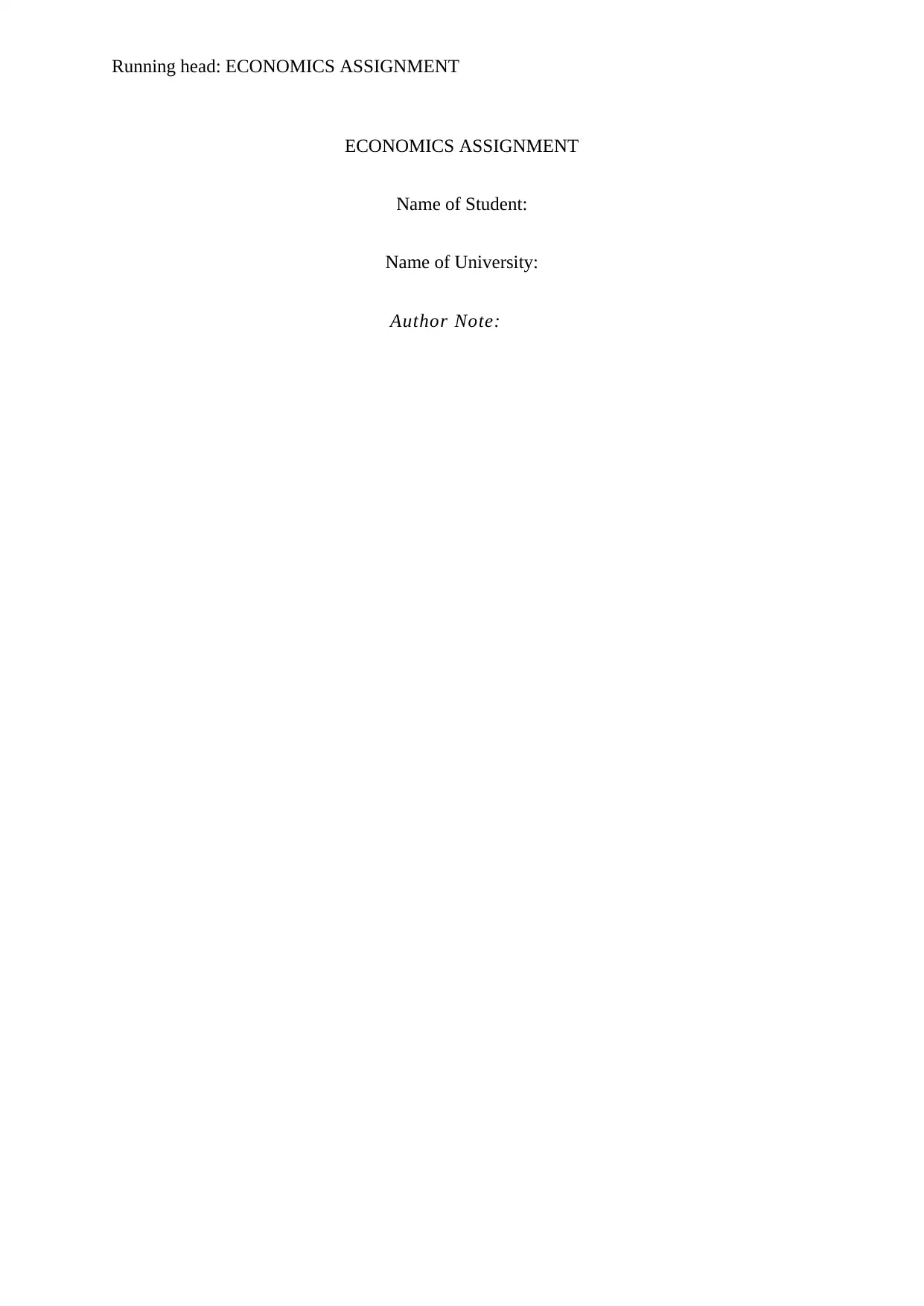
Running head: ECONOMICS ASSIGNMENT
ECONOMICS ASSIGNMENT
Name of Student:
Name of University:
Author Note:
ECONOMICS ASSIGNMENT
Name of Student:
Name of University:
Author Note:
Paraphrase This Document
Need a fresh take? Get an instant paraphrase of this document with our AI Paraphraser
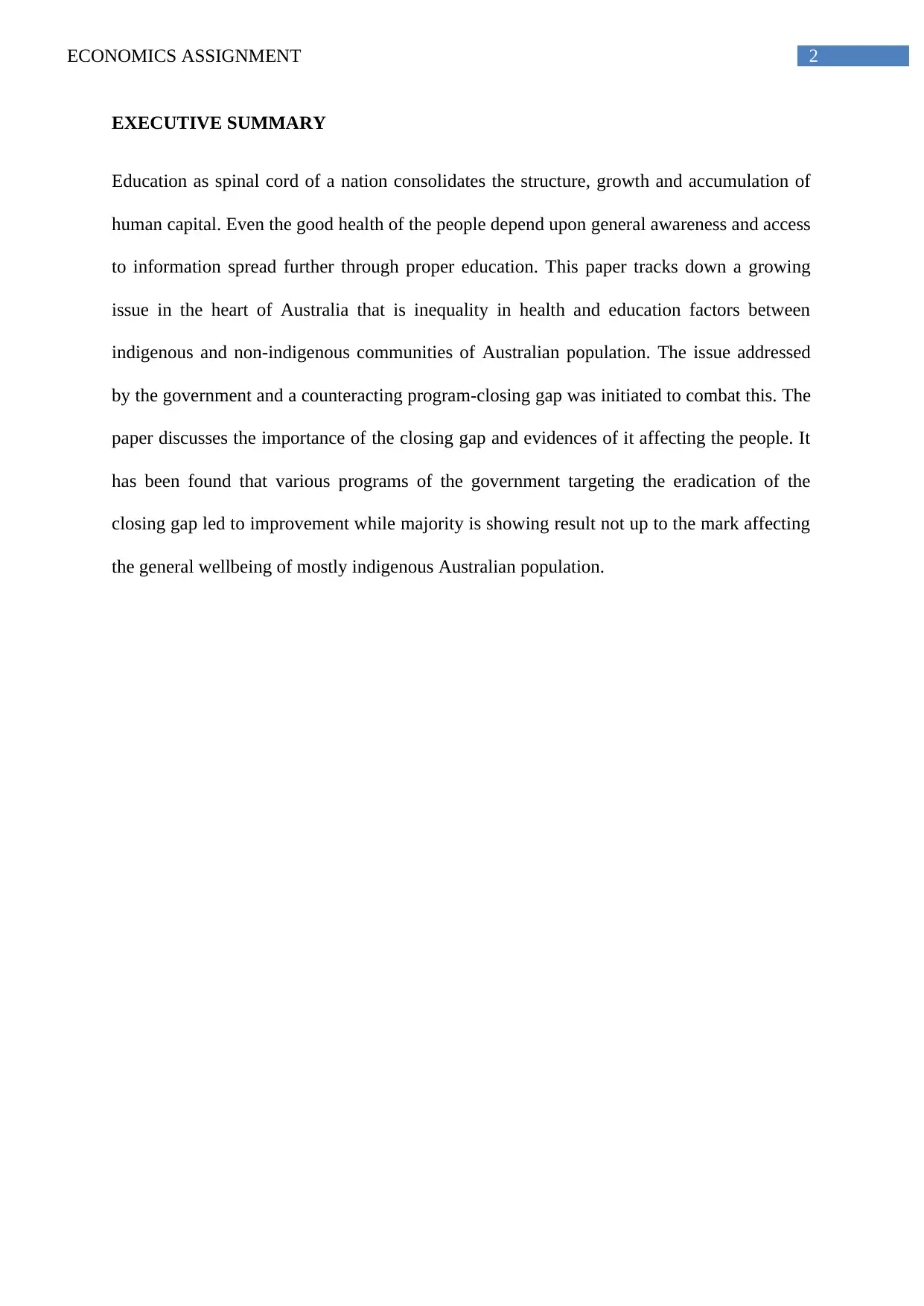
2ECONOMICS ASSIGNMENT
EXECUTIVE SUMMARY
Education as spinal cord of a nation consolidates the structure, growth and accumulation of
human capital. Even the good health of the people depend upon general awareness and access
to information spread further through proper education. This paper tracks down a growing
issue in the heart of Australia that is inequality in health and education factors between
indigenous and non-indigenous communities of Australian population. The issue addressed
by the government and a counteracting program-closing gap was initiated to combat this. The
paper discusses the importance of the closing gap and evidences of it affecting the people. It
has been found that various programs of the government targeting the eradication of the
closing gap led to improvement while majority is showing result not up to the mark affecting
the general wellbeing of mostly indigenous Australian population.
EXECUTIVE SUMMARY
Education as spinal cord of a nation consolidates the structure, growth and accumulation of
human capital. Even the good health of the people depend upon general awareness and access
to information spread further through proper education. This paper tracks down a growing
issue in the heart of Australia that is inequality in health and education factors between
indigenous and non-indigenous communities of Australian population. The issue addressed
by the government and a counteracting program-closing gap was initiated to combat this. The
paper discusses the importance of the closing gap and evidences of it affecting the people. It
has been found that various programs of the government targeting the eradication of the
closing gap led to improvement while majority is showing result not up to the mark affecting
the general wellbeing of mostly indigenous Australian population.
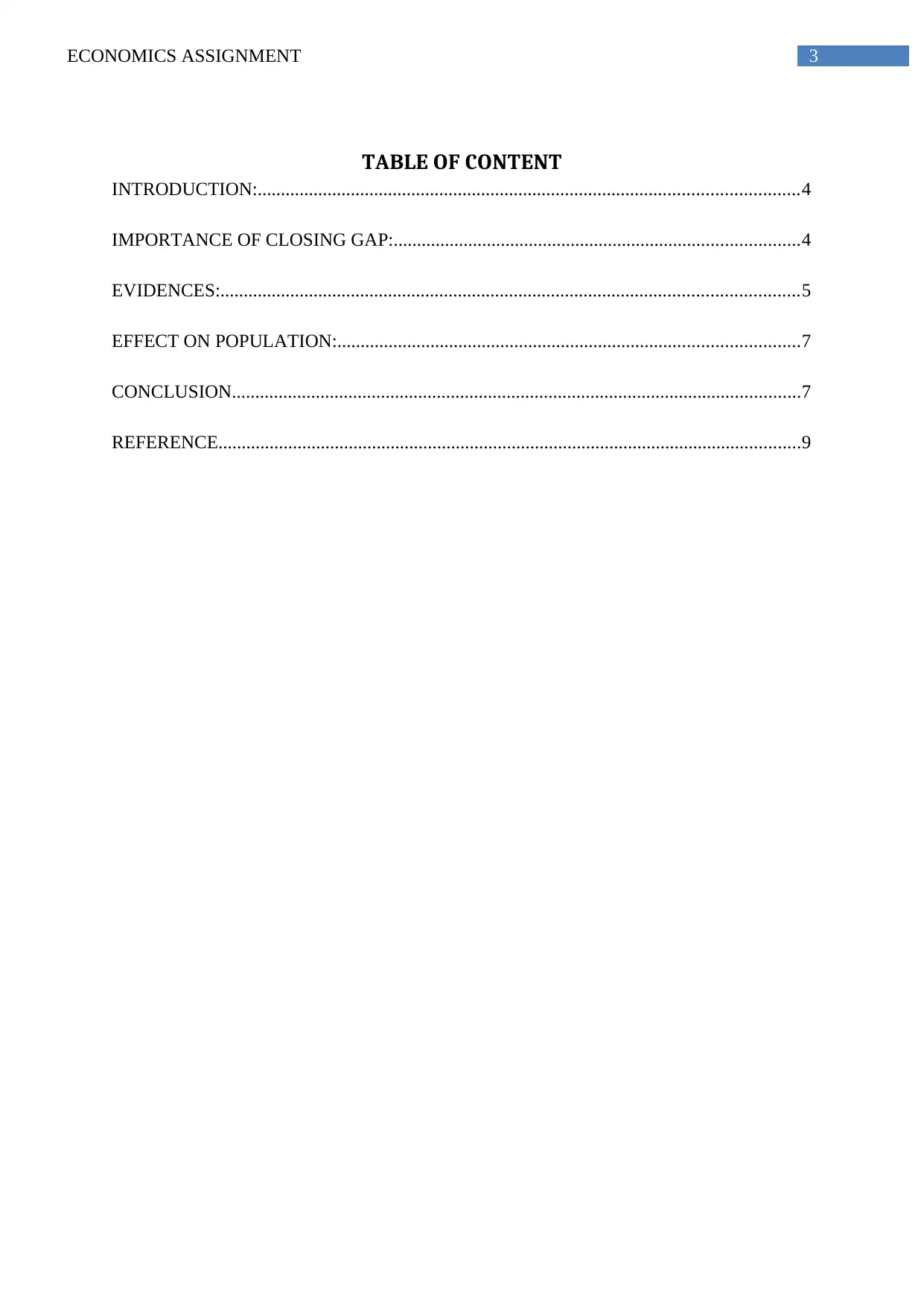
3ECONOMICS ASSIGNMENT
TABLE OF CONTENT
INTRODUCTION:....................................................................................................................4
IMPORTANCE OF CLOSING GAP:.......................................................................................4
EVIDENCES:............................................................................................................................5
EFFECT ON POPULATION:...................................................................................................7
CONCLUSION..........................................................................................................................7
REFERENCE.............................................................................................................................9
TABLE OF CONTENT
INTRODUCTION:....................................................................................................................4
IMPORTANCE OF CLOSING GAP:.......................................................................................4
EVIDENCES:............................................................................................................................5
EFFECT ON POPULATION:...................................................................................................7
CONCLUSION..........................................................................................................................7
REFERENCE.............................................................................................................................9
⊘ This is a preview!⊘
Do you want full access?
Subscribe today to unlock all pages.

Trusted by 1+ million students worldwide
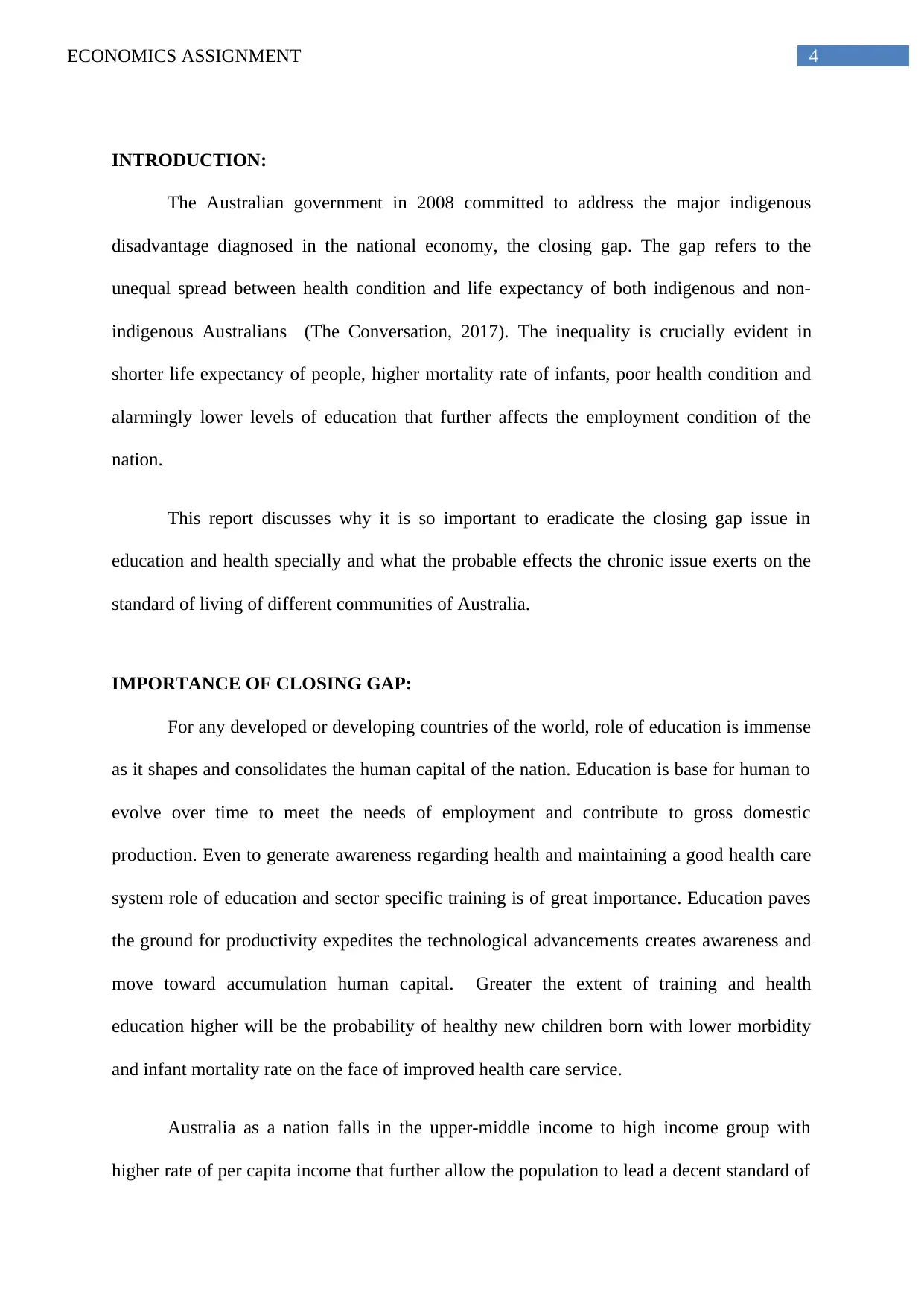
4ECONOMICS ASSIGNMENT
INTRODUCTION:
The Australian government in 2008 committed to address the major indigenous
disadvantage diagnosed in the national economy, the closing gap. The gap refers to the
unequal spread between health condition and life expectancy of both indigenous and non-
indigenous Australians (The Conversation, 2017). The inequality is crucially evident in
shorter life expectancy of people, higher mortality rate of infants, poor health condition and
alarmingly lower levels of education that further affects the employment condition of the
nation.
This report discusses why it is so important to eradicate the closing gap issue in
education and health specially and what the probable effects the chronic issue exerts on the
standard of living of different communities of Australia.
IMPORTANCE OF CLOSING GAP:
For any developed or developing countries of the world, role of education is immense
as it shapes and consolidates the human capital of the nation. Education is base for human to
evolve over time to meet the needs of employment and contribute to gross domestic
production. Even to generate awareness regarding health and maintaining a good health care
system role of education and sector specific training is of great importance. Education paves
the ground for productivity expedites the technological advancements creates awareness and
move toward accumulation human capital. Greater the extent of training and health
education higher will be the probability of healthy new children born with lower morbidity
and infant mortality rate on the face of improved health care service.
Australia as a nation falls in the upper-middle income to high income group with
higher rate of per capita income that further allow the population to lead a decent standard of
INTRODUCTION:
The Australian government in 2008 committed to address the major indigenous
disadvantage diagnosed in the national economy, the closing gap. The gap refers to the
unequal spread between health condition and life expectancy of both indigenous and non-
indigenous Australians (The Conversation, 2017). The inequality is crucially evident in
shorter life expectancy of people, higher mortality rate of infants, poor health condition and
alarmingly lower levels of education that further affects the employment condition of the
nation.
This report discusses why it is so important to eradicate the closing gap issue in
education and health specially and what the probable effects the chronic issue exerts on the
standard of living of different communities of Australia.
IMPORTANCE OF CLOSING GAP:
For any developed or developing countries of the world, role of education is immense
as it shapes and consolidates the human capital of the nation. Education is base for human to
evolve over time to meet the needs of employment and contribute to gross domestic
production. Even to generate awareness regarding health and maintaining a good health care
system role of education and sector specific training is of great importance. Education paves
the ground for productivity expedites the technological advancements creates awareness and
move toward accumulation human capital. Greater the extent of training and health
education higher will be the probability of healthy new children born with lower morbidity
and infant mortality rate on the face of improved health care service.
Australia as a nation falls in the upper-middle income to high income group with
higher rate of per capita income that further allow the population to lead a decent standard of
Paraphrase This Document
Need a fresh take? Get an instant paraphrase of this document with our AI Paraphraser
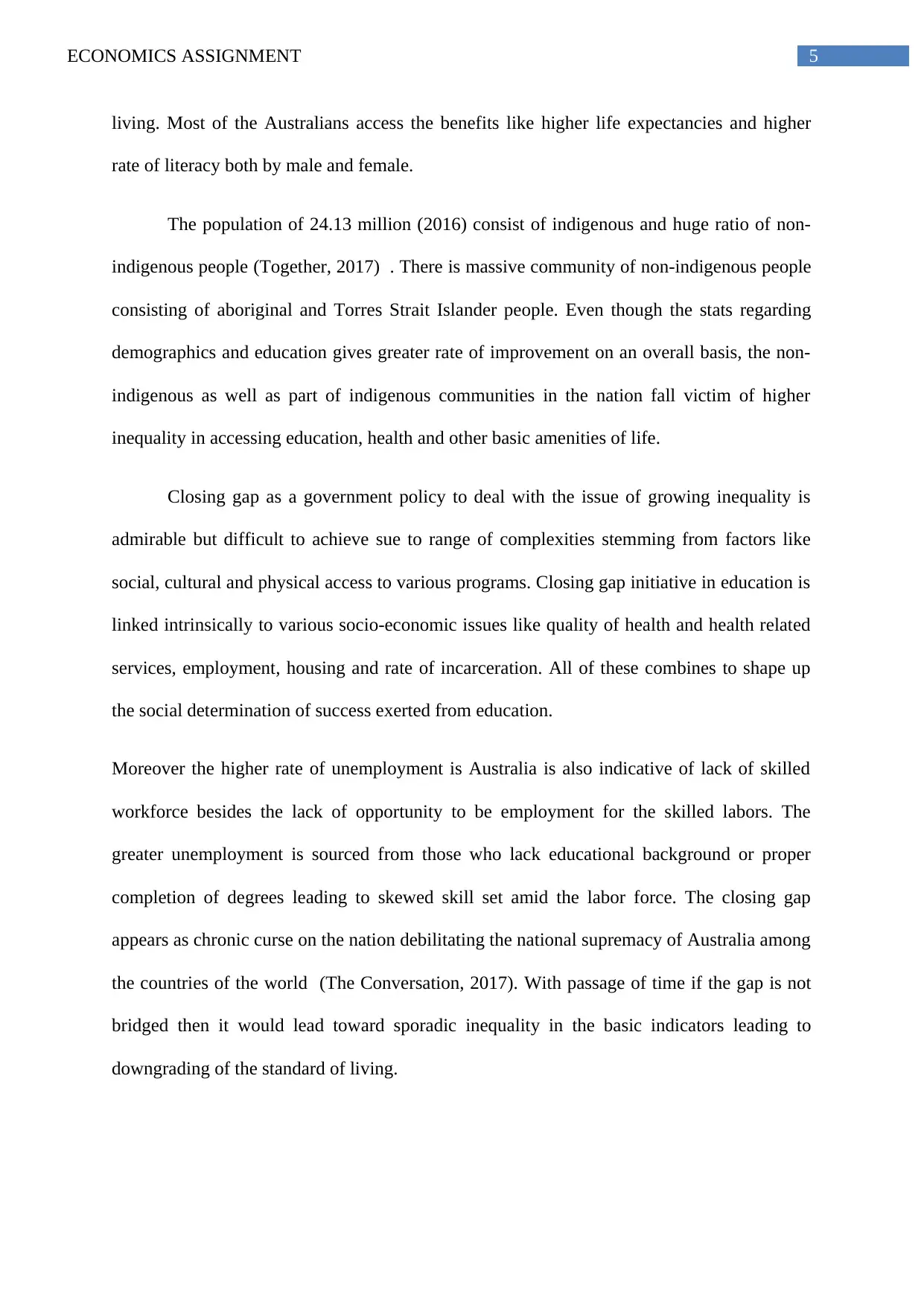
5ECONOMICS ASSIGNMENT
living. Most of the Australians access the benefits like higher life expectancies and higher
rate of literacy both by male and female.
The population of 24.13 million (2016) consist of indigenous and huge ratio of non-
indigenous people (Together, 2017) . There is massive community of non-indigenous people
consisting of aboriginal and Torres Strait Islander people. Even though the stats regarding
demographics and education gives greater rate of improvement on an overall basis, the non-
indigenous as well as part of indigenous communities in the nation fall victim of higher
inequality in accessing education, health and other basic amenities of life.
Closing gap as a government policy to deal with the issue of growing inequality is
admirable but difficult to achieve sue to range of complexities stemming from factors like
social, cultural and physical access to various programs. Closing gap initiative in education is
linked intrinsically to various socio-economic issues like quality of health and health related
services, employment, housing and rate of incarceration. All of these combines to shape up
the social determination of success exerted from education.
Moreover the higher rate of unemployment is Australia is also indicative of lack of skilled
workforce besides the lack of opportunity to be employment for the skilled labors. The
greater unemployment is sourced from those who lack educational background or proper
completion of degrees leading to skewed skill set amid the labor force. The closing gap
appears as chronic curse on the nation debilitating the national supremacy of Australia among
the countries of the world (The Conversation, 2017). With passage of time if the gap is not
bridged then it would lead toward sporadic inequality in the basic indicators leading to
downgrading of the standard of living.
living. Most of the Australians access the benefits like higher life expectancies and higher
rate of literacy both by male and female.
The population of 24.13 million (2016) consist of indigenous and huge ratio of non-
indigenous people (Together, 2017) . There is massive community of non-indigenous people
consisting of aboriginal and Torres Strait Islander people. Even though the stats regarding
demographics and education gives greater rate of improvement on an overall basis, the non-
indigenous as well as part of indigenous communities in the nation fall victim of higher
inequality in accessing education, health and other basic amenities of life.
Closing gap as a government policy to deal with the issue of growing inequality is
admirable but difficult to achieve sue to range of complexities stemming from factors like
social, cultural and physical access to various programs. Closing gap initiative in education is
linked intrinsically to various socio-economic issues like quality of health and health related
services, employment, housing and rate of incarceration. All of these combines to shape up
the social determination of success exerted from education.
Moreover the higher rate of unemployment is Australia is also indicative of lack of skilled
workforce besides the lack of opportunity to be employment for the skilled labors. The
greater unemployment is sourced from those who lack educational background or proper
completion of degrees leading to skewed skill set amid the labor force. The closing gap
appears as chronic curse on the nation debilitating the national supremacy of Australia among
the countries of the world (The Conversation, 2017). With passage of time if the gap is not
bridged then it would lead toward sporadic inequality in the basic indicators leading to
downgrading of the standard of living.
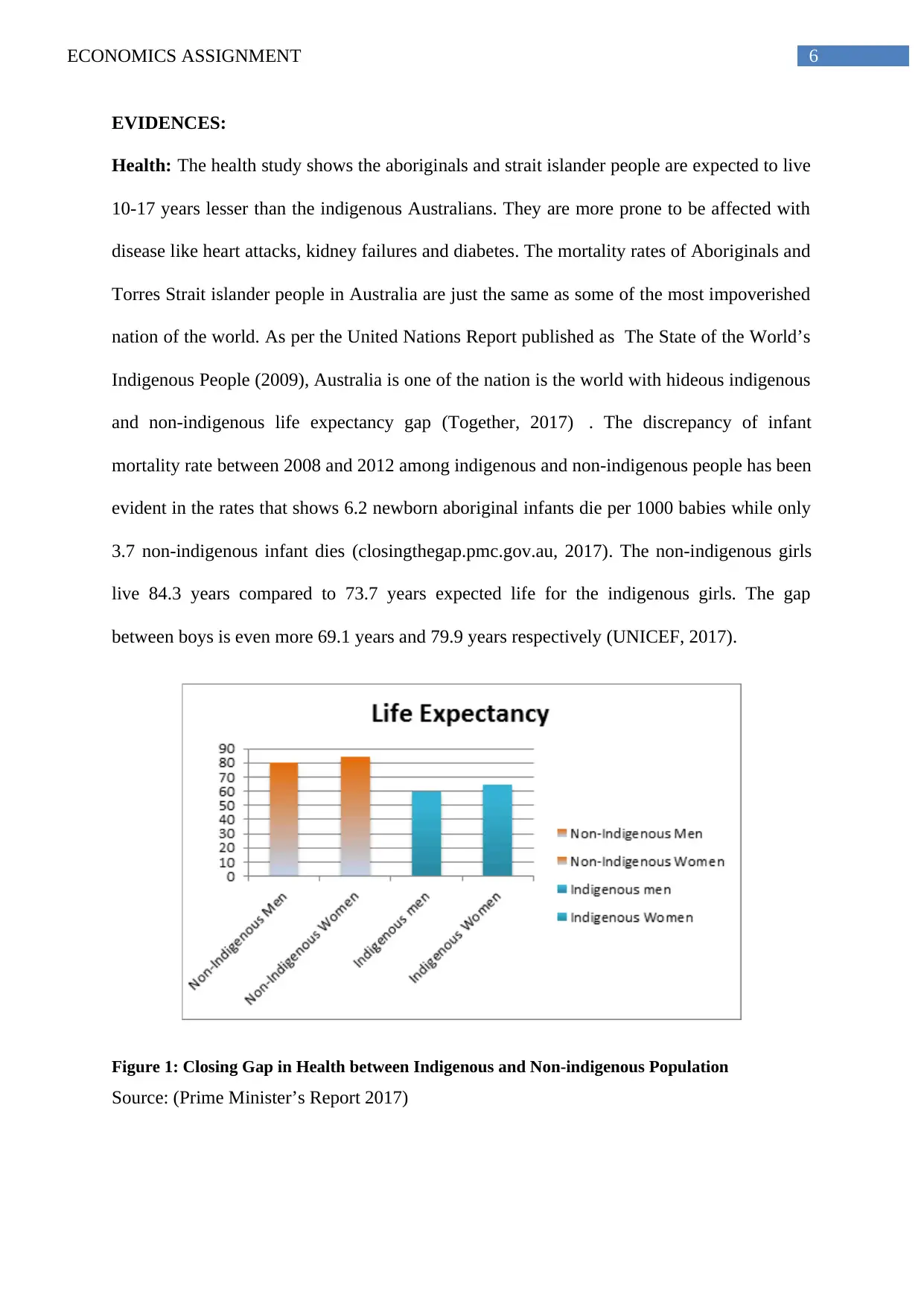
6ECONOMICS ASSIGNMENT
EVIDENCES:
Health: The health study shows the aboriginals and strait islander people are expected to live
10-17 years lesser than the indigenous Australians. They are more prone to be affected with
disease like heart attacks, kidney failures and diabetes. The mortality rates of Aboriginals and
Torres Strait islander people in Australia are just the same as some of the most impoverished
nation of the world. As per the United Nations Report published as The State of the World’s
Indigenous People (2009), Australia is one of the nation is the world with hideous indigenous
and non-indigenous life expectancy gap (Together, 2017) . The discrepancy of infant
mortality rate between 2008 and 2012 among indigenous and non-indigenous people has been
evident in the rates that shows 6.2 newborn aboriginal infants die per 1000 babies while only
3.7 non-indigenous infant dies (closingthegap.pmc.gov.au, 2017). The non-indigenous girls
live 84.3 years compared to 73.7 years expected life for the indigenous girls. The gap
between boys is even more 69.1 years and 79.9 years respectively (UNICEF, 2017).
Figure 1: Closing Gap in Health between Indigenous and Non-indigenous Population
Source: (Prime Minister’s Report 2017)
EVIDENCES:
Health: The health study shows the aboriginals and strait islander people are expected to live
10-17 years lesser than the indigenous Australians. They are more prone to be affected with
disease like heart attacks, kidney failures and diabetes. The mortality rates of Aboriginals and
Torres Strait islander people in Australia are just the same as some of the most impoverished
nation of the world. As per the United Nations Report published as The State of the World’s
Indigenous People (2009), Australia is one of the nation is the world with hideous indigenous
and non-indigenous life expectancy gap (Together, 2017) . The discrepancy of infant
mortality rate between 2008 and 2012 among indigenous and non-indigenous people has been
evident in the rates that shows 6.2 newborn aboriginal infants die per 1000 babies while only
3.7 non-indigenous infant dies (closingthegap.pmc.gov.au, 2017). The non-indigenous girls
live 84.3 years compared to 73.7 years expected life for the indigenous girls. The gap
between boys is even more 69.1 years and 79.9 years respectively (UNICEF, 2017).
Figure 1: Closing Gap in Health between Indigenous and Non-indigenous Population
Source: (Prime Minister’s Report 2017)
⊘ This is a preview!⊘
Do you want full access?
Subscribe today to unlock all pages.

Trusted by 1+ million students worldwide
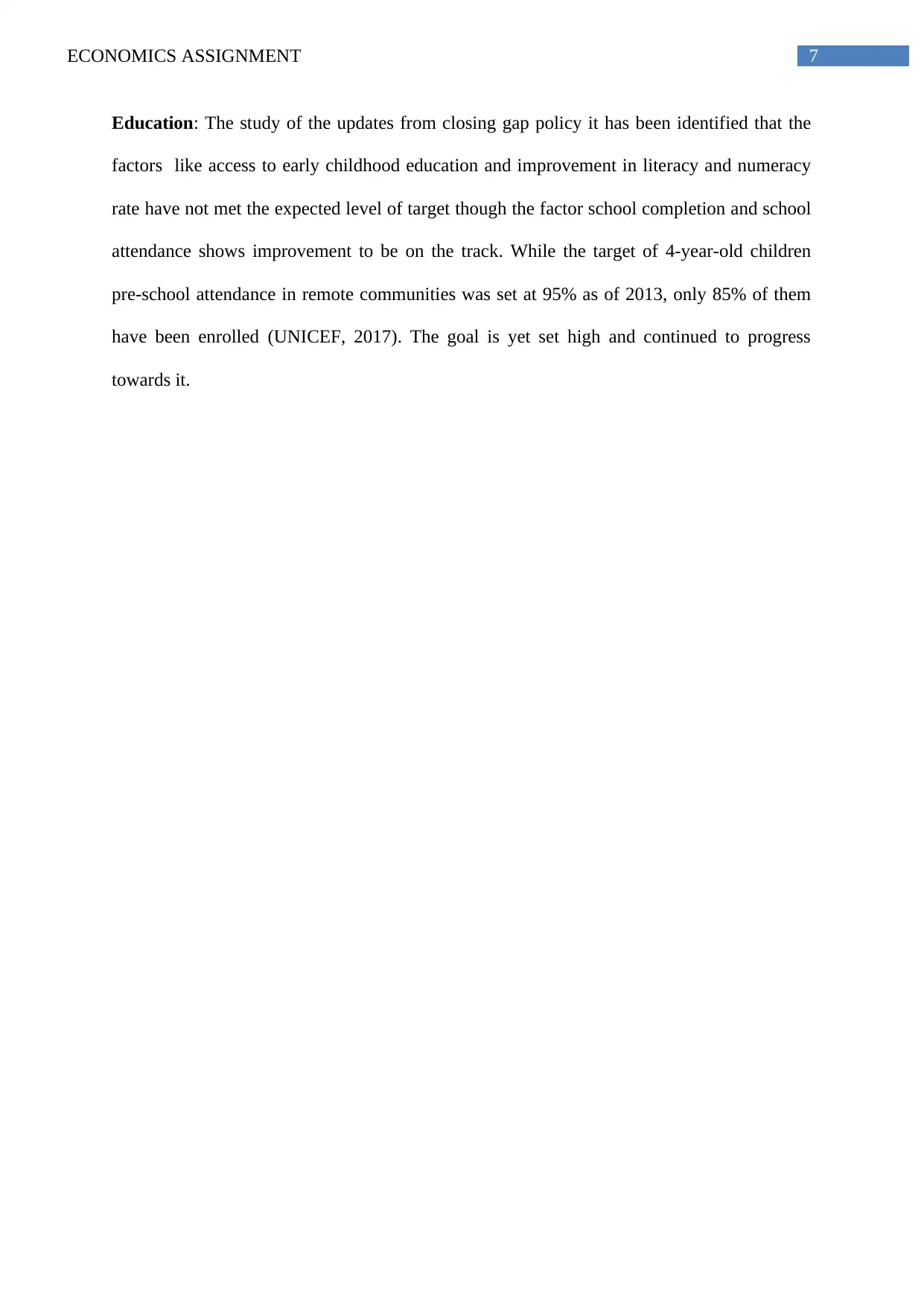
7ECONOMICS ASSIGNMENT
Education: The study of the updates from closing gap policy it has been identified that the
factors like access to early childhood education and improvement in literacy and numeracy
rate have not met the expected level of target though the factor school completion and school
attendance shows improvement to be on the track. While the target of 4-year-old children
pre-school attendance in remote communities was set at 95% as of 2013, only 85% of them
have been enrolled (UNICEF, 2017). The goal is yet set high and continued to progress
towards it.
Education: The study of the updates from closing gap policy it has been identified that the
factors like access to early childhood education and improvement in literacy and numeracy
rate have not met the expected level of target though the factor school completion and school
attendance shows improvement to be on the track. While the target of 4-year-old children
pre-school attendance in remote communities was set at 95% as of 2013, only 85% of them
have been enrolled (UNICEF, 2017). The goal is yet set high and continued to progress
towards it.
Paraphrase This Document
Need a fresh take? Get an instant paraphrase of this document with our AI Paraphraser
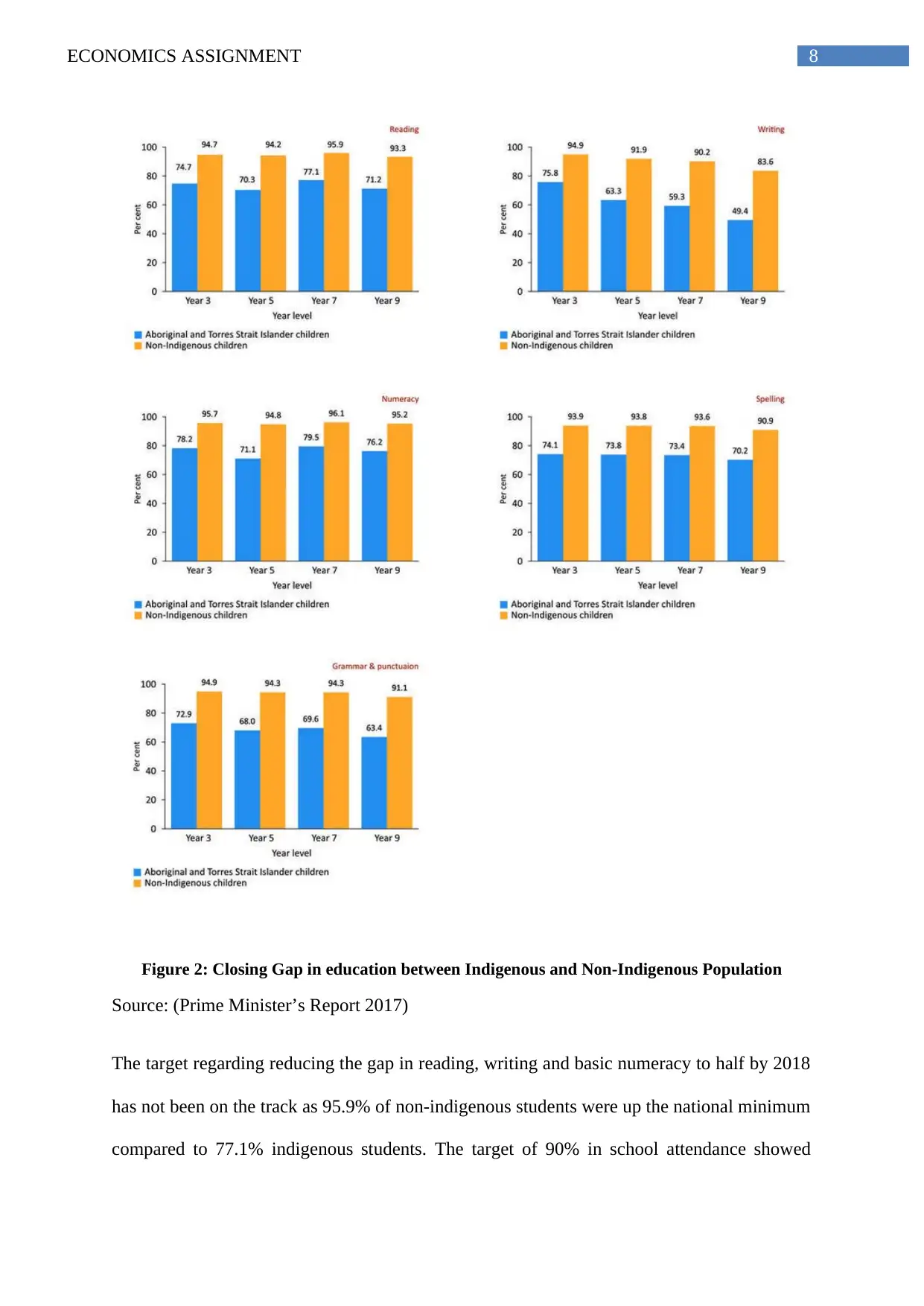
8ECONOMICS ASSIGNMENT
Figure 2: Closing Gap in education between Indigenous and Non-Indigenous Population
Source: (Prime Minister’s Report 2017)
The target regarding reducing the gap in reading, writing and basic numeracy to half by 2018
has not been on the track as 95.9% of non-indigenous students were up the national minimum
compared to 77.1% indigenous students. The target of 90% in school attendance showed
Figure 2: Closing Gap in education between Indigenous and Non-Indigenous Population
Source: (Prime Minister’s Report 2017)
The target regarding reducing the gap in reading, writing and basic numeracy to half by 2018
has not been on the track as 95.9% of non-indigenous students were up the national minimum
compared to 77.1% indigenous students. The target of 90% in school attendance showed
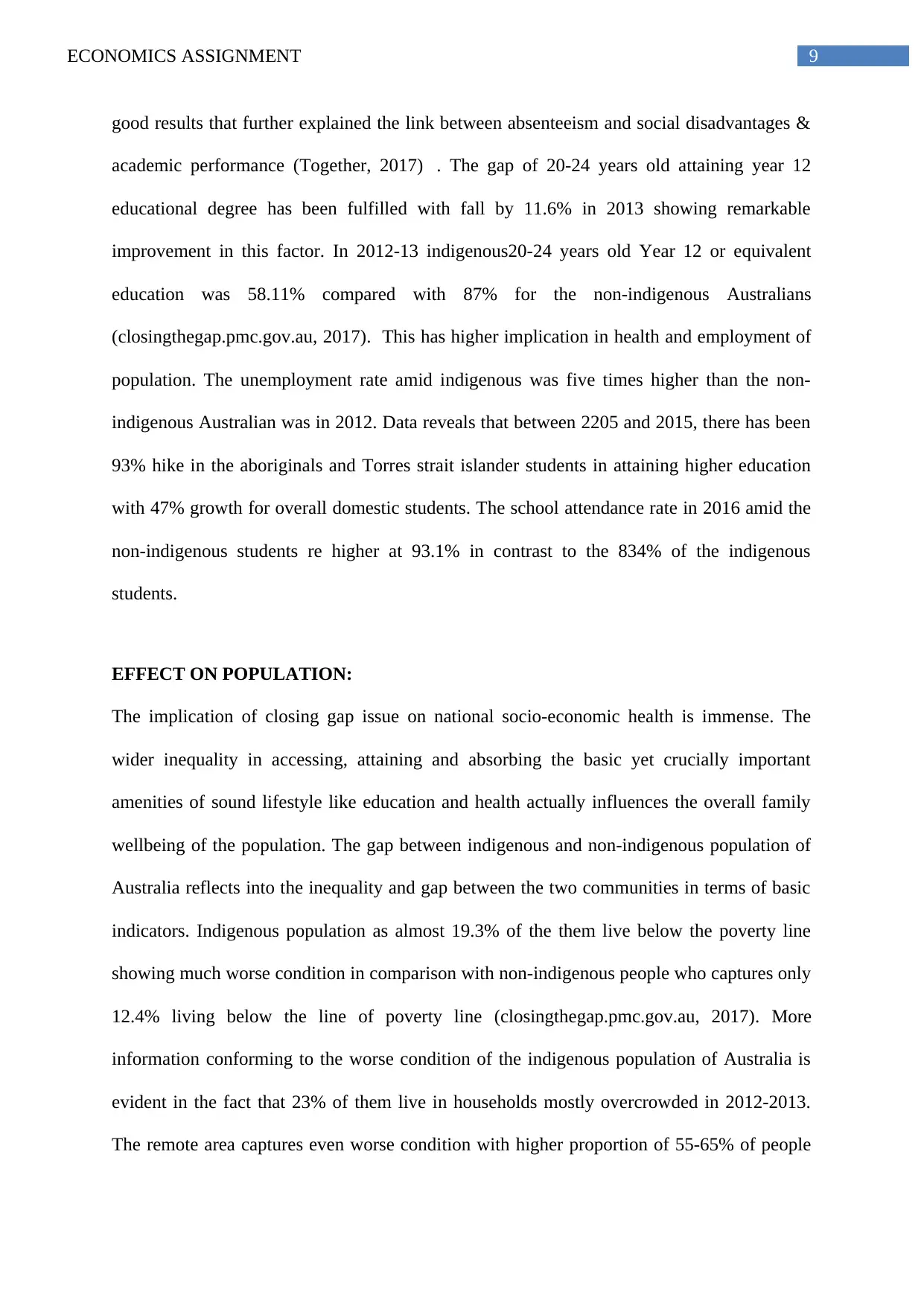
9ECONOMICS ASSIGNMENT
good results that further explained the link between absenteeism and social disadvantages &
academic performance (Together, 2017) . The gap of 20-24 years old attaining year 12
educational degree has been fulfilled with fall by 11.6% in 2013 showing remarkable
improvement in this factor. In 2012-13 indigenous20-24 years old Year 12 or equivalent
education was 58.11% compared with 87% for the non-indigenous Australians
(closingthegap.pmc.gov.au, 2017). This has higher implication in health and employment of
population. The unemployment rate amid indigenous was five times higher than the non-
indigenous Australian was in 2012. Data reveals that between 2205 and 2015, there has been
93% hike in the aboriginals and Torres strait islander students in attaining higher education
with 47% growth for overall domestic students. The school attendance rate in 2016 amid the
non-indigenous students re higher at 93.1% in contrast to the 834% of the indigenous
students.
EFFECT ON POPULATION:
The implication of closing gap issue on national socio-economic health is immense. The
wider inequality in accessing, attaining and absorbing the basic yet crucially important
amenities of sound lifestyle like education and health actually influences the overall family
wellbeing of the population. The gap between indigenous and non-indigenous population of
Australia reflects into the inequality and gap between the two communities in terms of basic
indicators. Indigenous population as almost 19.3% of the them live below the poverty line
showing much worse condition in comparison with non-indigenous people who captures only
12.4% living below the line of poverty line (closingthegap.pmc.gov.au, 2017). More
information conforming to the worse condition of the indigenous population of Australia is
evident in the fact that 23% of them live in households mostly overcrowded in 2012-2013.
The remote area captures even worse condition with higher proportion of 55-65% of people
good results that further explained the link between absenteeism and social disadvantages &
academic performance (Together, 2017) . The gap of 20-24 years old attaining year 12
educational degree has been fulfilled with fall by 11.6% in 2013 showing remarkable
improvement in this factor. In 2012-13 indigenous20-24 years old Year 12 or equivalent
education was 58.11% compared with 87% for the non-indigenous Australians
(closingthegap.pmc.gov.au, 2017). This has higher implication in health and employment of
population. The unemployment rate amid indigenous was five times higher than the non-
indigenous Australian was in 2012. Data reveals that between 2205 and 2015, there has been
93% hike in the aboriginals and Torres strait islander students in attaining higher education
with 47% growth for overall domestic students. The school attendance rate in 2016 amid the
non-indigenous students re higher at 93.1% in contrast to the 834% of the indigenous
students.
EFFECT ON POPULATION:
The implication of closing gap issue on national socio-economic health is immense. The
wider inequality in accessing, attaining and absorbing the basic yet crucially important
amenities of sound lifestyle like education and health actually influences the overall family
wellbeing of the population. The gap between indigenous and non-indigenous population of
Australia reflects into the inequality and gap between the two communities in terms of basic
indicators. Indigenous population as almost 19.3% of the them live below the poverty line
showing much worse condition in comparison with non-indigenous people who captures only
12.4% living below the line of poverty line (closingthegap.pmc.gov.au, 2017). More
information conforming to the worse condition of the indigenous population of Australia is
evident in the fact that 23% of them live in households mostly overcrowded in 2012-2013.
The remote area captures even worse condition with higher proportion of 55-65% of people
⊘ This is a preview!⊘
Do you want full access?
Subscribe today to unlock all pages.

Trusted by 1+ million students worldwide
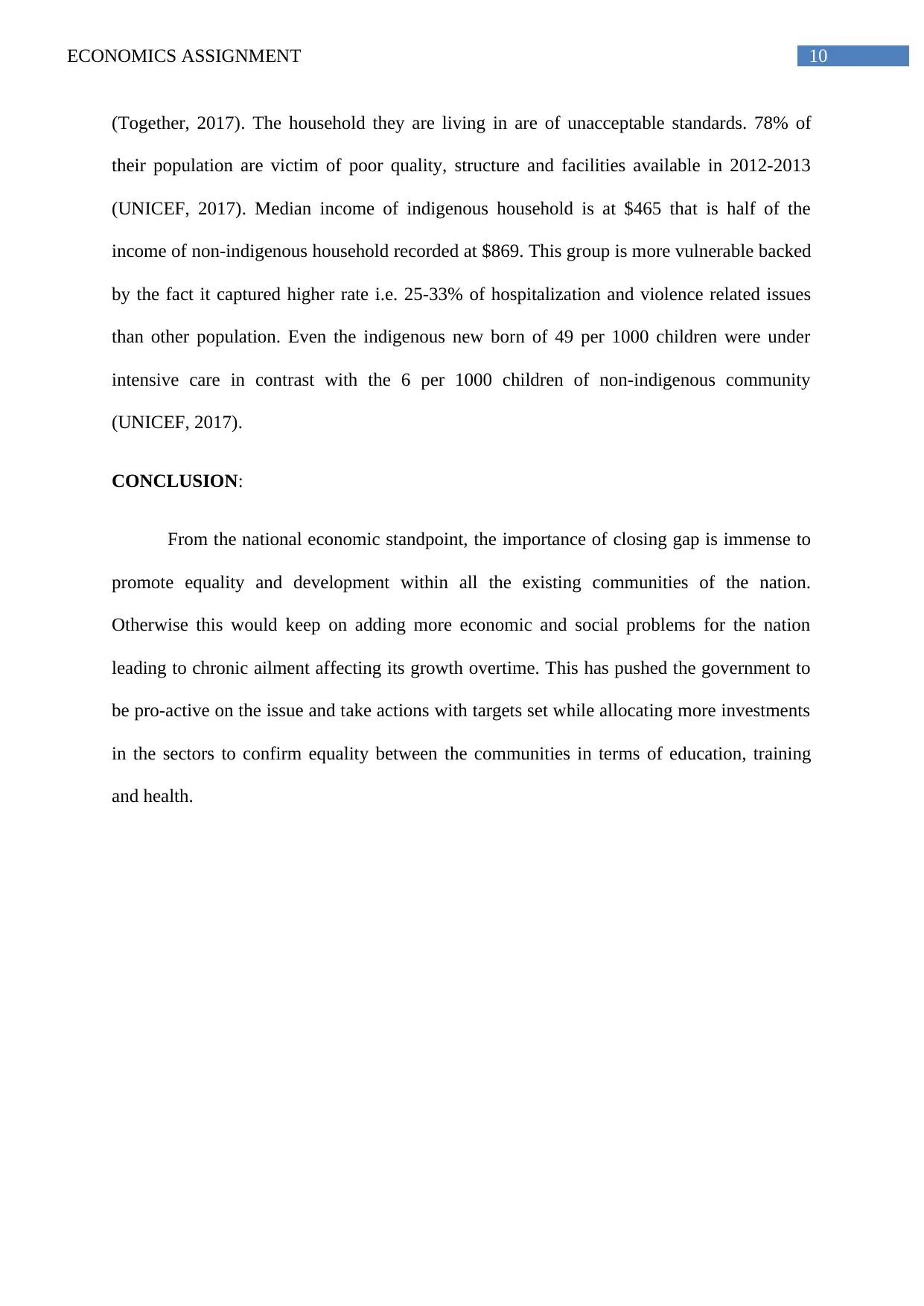
10ECONOMICS ASSIGNMENT
(Together, 2017). The household they are living in are of unacceptable standards. 78% of
their population are victim of poor quality, structure and facilities available in 2012-2013
(UNICEF, 2017). Median income of indigenous household is at $465 that is half of the
income of non-indigenous household recorded at $869. This group is more vulnerable backed
by the fact it captured higher rate i.e. 25-33% of hospitalization and violence related issues
than other population. Even the indigenous new born of 49 per 1000 children were under
intensive care in contrast with the 6 per 1000 children of non-indigenous community
(UNICEF, 2017).
CONCLUSION:
From the national economic standpoint, the importance of closing gap is immense to
promote equality and development within all the existing communities of the nation.
Otherwise this would keep on adding more economic and social problems for the nation
leading to chronic ailment affecting its growth overtime. This has pushed the government to
be pro-active on the issue and take actions with targets set while allocating more investments
in the sectors to confirm equality between the communities in terms of education, training
and health.
(Together, 2017). The household they are living in are of unacceptable standards. 78% of
their population are victim of poor quality, structure and facilities available in 2012-2013
(UNICEF, 2017). Median income of indigenous household is at $465 that is half of the
income of non-indigenous household recorded at $869. This group is more vulnerable backed
by the fact it captured higher rate i.e. 25-33% of hospitalization and violence related issues
than other population. Even the indigenous new born of 49 per 1000 children were under
intensive care in contrast with the 6 per 1000 children of non-indigenous community
(UNICEF, 2017).
CONCLUSION:
From the national economic standpoint, the importance of closing gap is immense to
promote equality and development within all the existing communities of the nation.
Otherwise this would keep on adding more economic and social problems for the nation
leading to chronic ailment affecting its growth overtime. This has pushed the government to
be pro-active on the issue and take actions with targets set while allocating more investments
in the sectors to confirm equality between the communities in terms of education, training
and health.
Paraphrase This Document
Need a fresh take? Get an instant paraphrase of this document with our AI Paraphraser
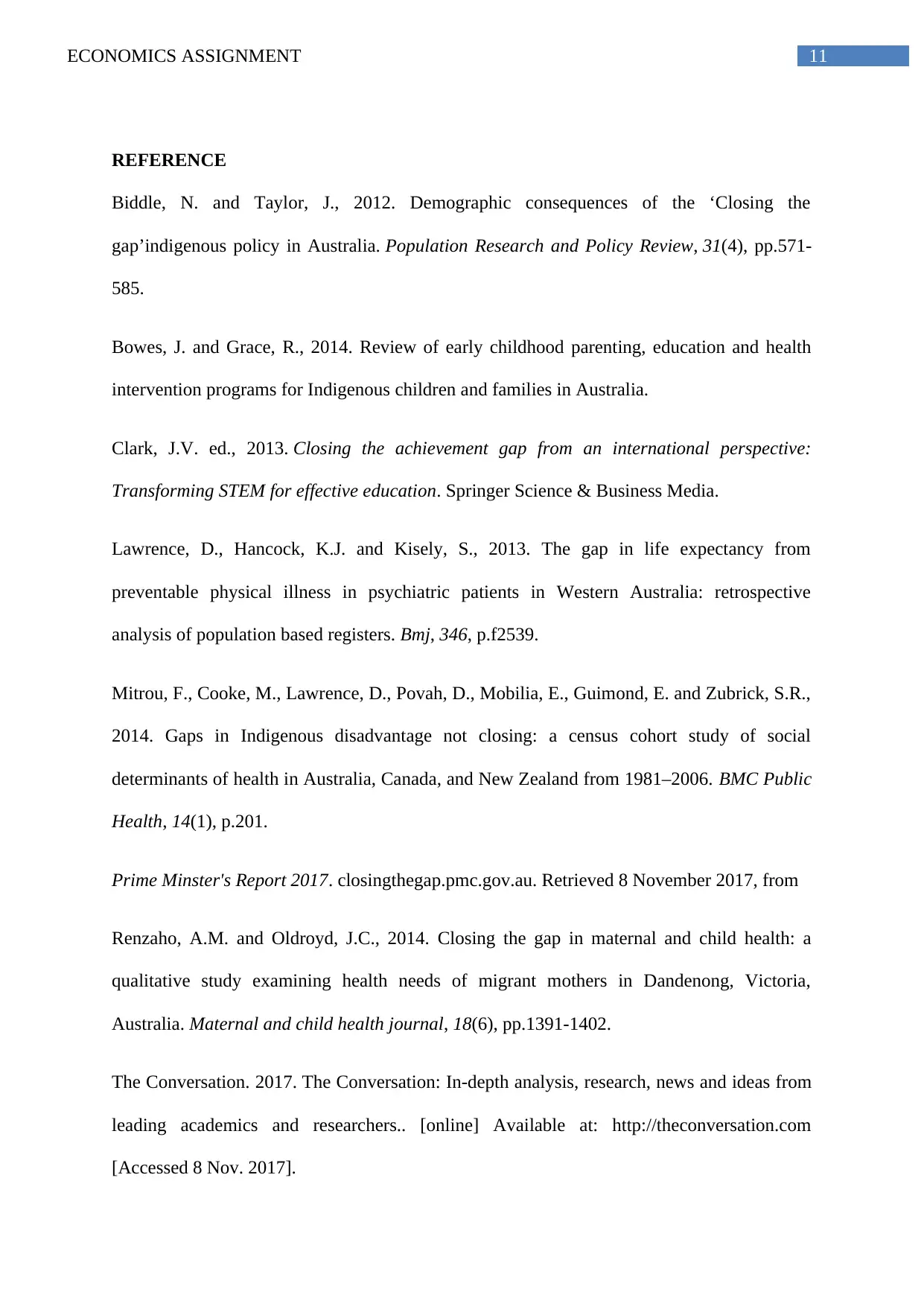
11ECONOMICS ASSIGNMENT
REFERENCE
Biddle, N. and Taylor, J., 2012. Demographic consequences of the ‘Closing the
gap’indigenous policy in Australia. Population Research and Policy Review, 31(4), pp.571-
585.
Bowes, J. and Grace, R., 2014. Review of early childhood parenting, education and health
intervention programs for Indigenous children and families in Australia.
Clark, J.V. ed., 2013. Closing the achievement gap from an international perspective:
Transforming STEM for effective education. Springer Science & Business Media.
Lawrence, D., Hancock, K.J. and Kisely, S., 2013. The gap in life expectancy from
preventable physical illness in psychiatric patients in Western Australia: retrospective
analysis of population based registers. Bmj, 346, p.f2539.
Mitrou, F., Cooke, M., Lawrence, D., Povah, D., Mobilia, E., Guimond, E. and Zubrick, S.R.,
2014. Gaps in Indigenous disadvantage not closing: a census cohort study of social
determinants of health in Australia, Canada, and New Zealand from 1981–2006. BMC Public
Health, 14(1), p.201.
Prime Minster's Report 2017. closingthegap.pmc.gov.au. Retrieved 8 November 2017, from
Renzaho, A.M. and Oldroyd, J.C., 2014. Closing the gap in maternal and child health: a
qualitative study examining health needs of migrant mothers in Dandenong, Victoria,
Australia. Maternal and child health journal, 18(6), pp.1391-1402.
The Conversation. 2017. The Conversation: In-depth analysis, research, news and ideas from
leading academics and researchers.. [online] Available at: http://theconversation.com
[Accessed 8 Nov. 2017].
REFERENCE
Biddle, N. and Taylor, J., 2012. Demographic consequences of the ‘Closing the
gap’indigenous policy in Australia. Population Research and Policy Review, 31(4), pp.571-
585.
Bowes, J. and Grace, R., 2014. Review of early childhood parenting, education and health
intervention programs for Indigenous children and families in Australia.
Clark, J.V. ed., 2013. Closing the achievement gap from an international perspective:
Transforming STEM for effective education. Springer Science & Business Media.
Lawrence, D., Hancock, K.J. and Kisely, S., 2013. The gap in life expectancy from
preventable physical illness in psychiatric patients in Western Australia: retrospective
analysis of population based registers. Bmj, 346, p.f2539.
Mitrou, F., Cooke, M., Lawrence, D., Povah, D., Mobilia, E., Guimond, E. and Zubrick, S.R.,
2014. Gaps in Indigenous disadvantage not closing: a census cohort study of social
determinants of health in Australia, Canada, and New Zealand from 1981–2006. BMC Public
Health, 14(1), p.201.
Prime Minster's Report 2017. closingthegap.pmc.gov.au. Retrieved 8 November 2017, from
Renzaho, A.M. and Oldroyd, J.C., 2014. Closing the gap in maternal and child health: a
qualitative study examining health needs of migrant mothers in Dandenong, Victoria,
Australia. Maternal and child health journal, 18(6), pp.1391-1402.
The Conversation. 2017. The Conversation: In-depth analysis, research, news and ideas from
leading academics and researchers.. [online] Available at: http://theconversation.com
[Accessed 8 Nov. 2017].
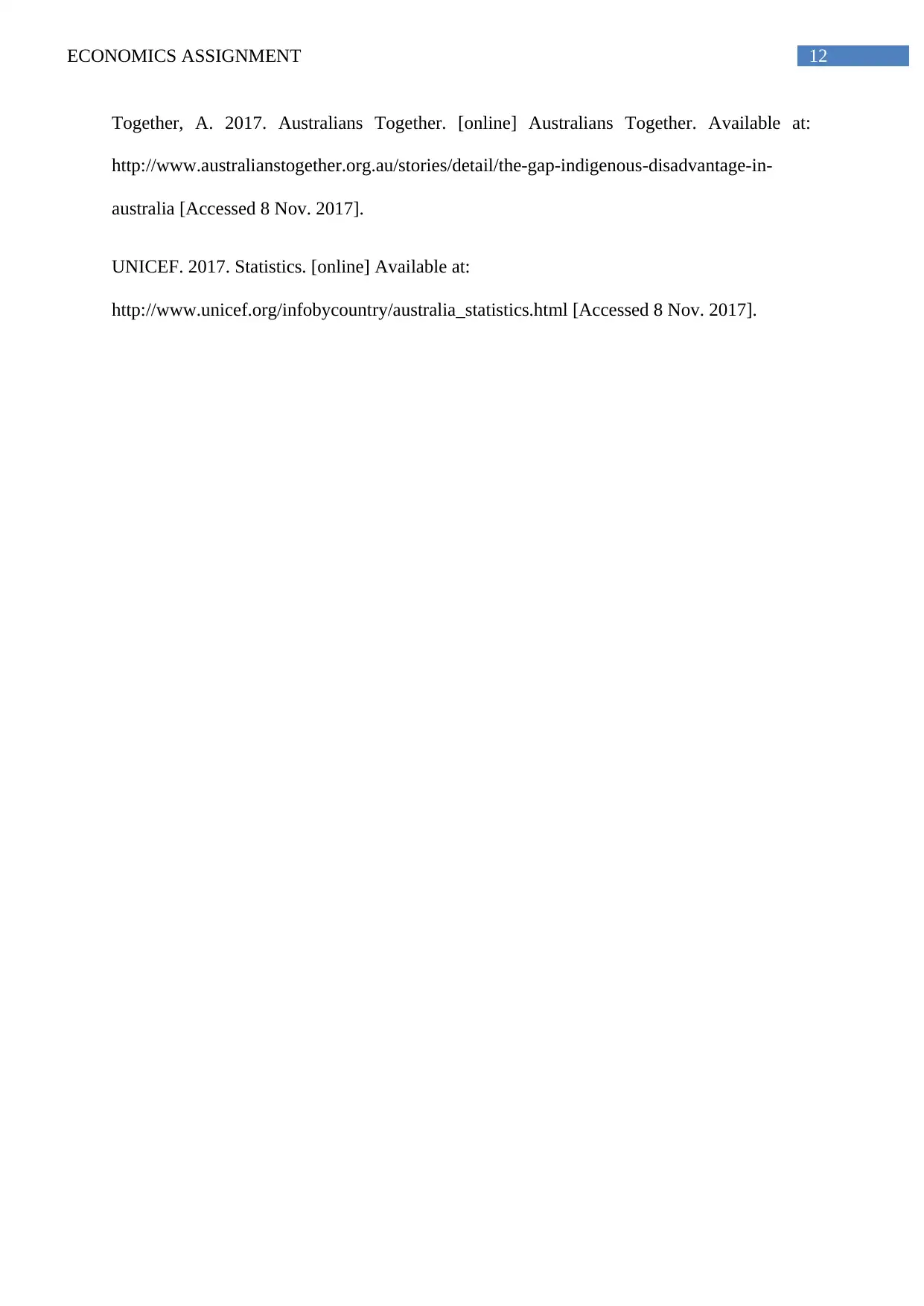
12ECONOMICS ASSIGNMENT
Together, A. 2017. Australians Together. [online] Australians Together. Available at:
http://www.australianstogether.org.au/stories/detail/the-gap-indigenous-disadvantage-in-
australia [Accessed 8 Nov. 2017].
UNICEF. 2017. Statistics. [online] Available at:
http://www.unicef.org/infobycountry/australia_statistics.html [Accessed 8 Nov. 2017].
Together, A. 2017. Australians Together. [online] Australians Together. Available at:
http://www.australianstogether.org.au/stories/detail/the-gap-indigenous-disadvantage-in-
australia [Accessed 8 Nov. 2017].
UNICEF. 2017. Statistics. [online] Available at:
http://www.unicef.org/infobycountry/australia_statistics.html [Accessed 8 Nov. 2017].
⊘ This is a preview!⊘
Do you want full access?
Subscribe today to unlock all pages.

Trusted by 1+ million students worldwide
1 out of 12
Related Documents
Your All-in-One AI-Powered Toolkit for Academic Success.
+13062052269
info@desklib.com
Available 24*7 on WhatsApp / Email
![[object Object]](/_next/static/media/star-bottom.7253800d.svg)
Unlock your academic potential
Copyright © 2020–2025 A2Z Services. All Rights Reserved. Developed and managed by ZUCOL.





